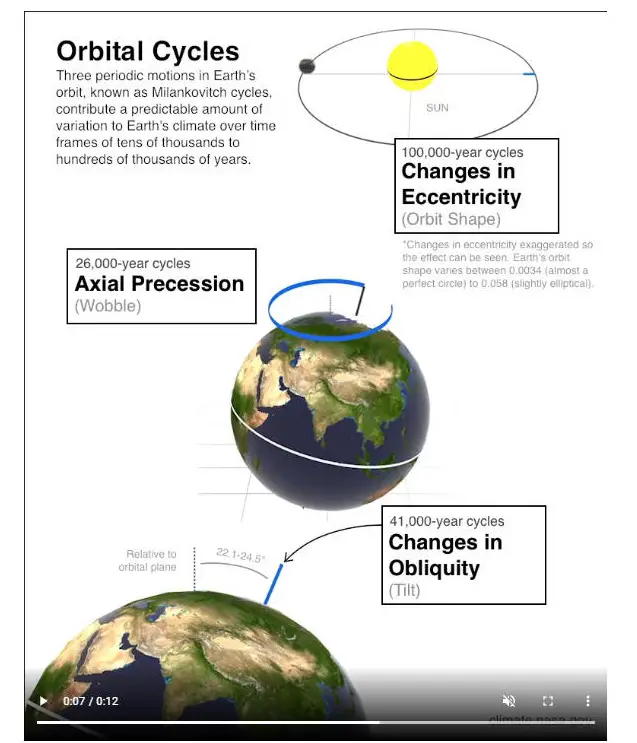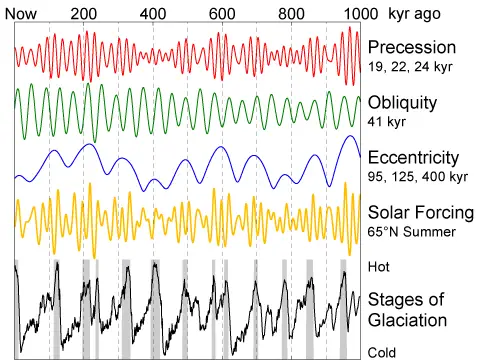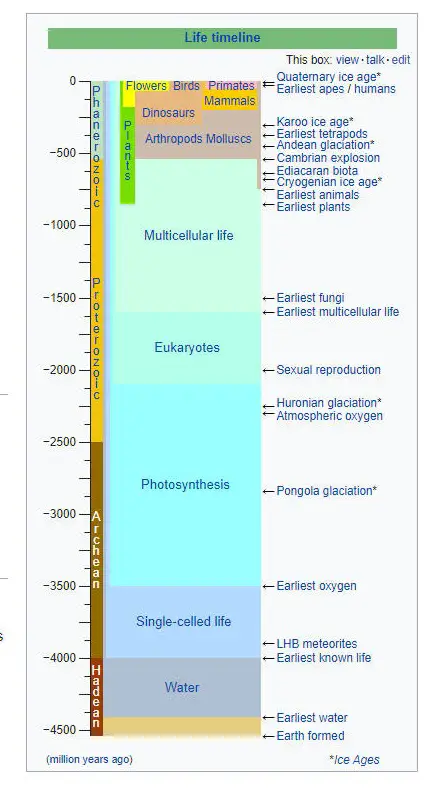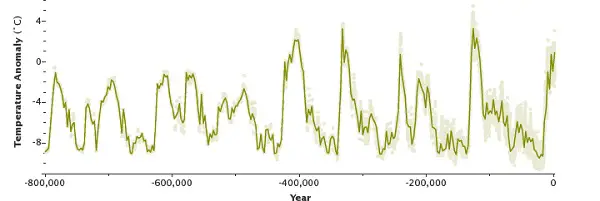Translate this page to any language by choosing a language in the box below.
One
 interesting and rarely discussed aspect of Earth's climate is the cyclic nature
of ice ages and warm periods.
interesting and rarely discussed aspect of Earth's climate is the cyclic nature
of ice ages and warm periods.
The media talks about climate change as if carbon dioxide levels are the only factor involved in them. But there are many factors that affect the onset, severity and decline of a warming or cooling period.
Almost all of these factors are completely independent of the existence of humans. The earth has been hanging around for about 4.6 billion years, and there have been many hot and cold periods, long before humanity existed, so we need to look back farther than the past 200 years, to understand the underlying causes.
After you let that sink in, add this: University of Maine glaciologist Brenda Hall says some of the evidence suggests that we are overdue for an ice age and that human-caused warming may be delaying an overdue ice age. The last ice age to 18,000 years ago, but warm periods (called interglacials) last about 15,000 years. All of which means, we are 1,000 to 3,000 years overdue for another ice age, which could be upon us, if it weren't for mankind's activity.
The entire planet enters and leaves ice ages at the same time, even though it would be expected that the northern and southern hemisphere's would be in opposition.
Ice-age cycles are primarily driven by periodic changes in the Earth’s orbit; see the diagram at right. There are 3 distinct orbital cycles; collectively called the Milankovitch cycles. NASA's Climate division tell s us
Serbian scientist Milutin Milankovitch hypothesized the long-term, collective effects of changes in Earth’s position relative to the Sun are a strong driver of Earth’s long-term climate, and are responsible for triggering the beginning and end of glaciation periods (Ice Ages).
Specifically, he examined how variations in three types of Earth orbital movements affect how much solar radiation (known as insolation) reaches the top of Earth’s atmosphere as well as where the insolation reaches. These cyclical orbital movements, which became known as the Milankovitch cycles, cause variations of up to 25 percent in the amount of incoming insolation at Earth’s mid-latitudes (the areas of our planet located between about 30 and 60 degrees north and south of the equator).
The Milankovitch cycles include:
- The shape of Earth’s orbit, known as eccentricity;
- The angle Earth’s axis is tilted with respect to Earth’s orbital plane, known as obliquity; and
- The direction Earth’s axis of rotation is pointed, known as precession
And here's a deeper explanation of each of these:
 sun is received at high latitudes
(and shifting how much reaches the north vs south).
sun is received at high latitudes
(and shifting how much reaches the north vs south).
As you can imagine, the interaction of these 3 cycles along with solar flares, asteroid strikes, continental drift, changing ocean currents, and
major volcanic events makes the coming and going of ice ages and warm periods far more complex, as shown in the chart at right.

There have been 5 major ice ages during Earth’s past climates, called “paleoclimates.” in which the entire planet becomes a frozen snowball. Think of the over-the-top disaster movie, "2020". Wikipedia has a chart (at right) that overlays those against the evolution of life on earth. Currently, the Earth is in the Holocene interglacial (warm) period, which began about 20,000 years ago.
From oldest to most recent:
In between these major ice ages there are the more common ice ages (glacial periods) and warm periods (interglacials). These are what most people think of as an "ice age" and include the period with the wooly mammoths that covered northern North America.
This graphic below, from NASA, shows that the temperature cycles frequently between warm and cold periods over the past 800,000 years and that today's warming is within that normal range.

Climate.gov has some nice graphics and explanations about the hottest periods in earth's post-initial cooling history here.
Here's an excerpt:
One of the warmest times was during the geologic period known as the Neoproterozoic, between 600 and 800 million years ago. Conditions were also frequently sweltering between 500 million and 250 million years ago. And within the last 100 million years, two major heat spikes occurred: the Cretaceous Hot Greenhouse (about 92 million years ago), and the Paleocene-Eocene Thermal Maximum (about 56 million years ago).
NASA's take upon this that the current warming is concerning, due to their prediction of the rate of future warming:
Models predict that Earth will warm between 2 and 6 degrees Celsius in the next century. When global warming has happened at various times in the past two million years, it has taken the planet about 5,000 years to warm 5 degrees. The predicted rate of warming for the next century is at least 20 times faster. This rate of change is extremely unusual.
We've bold-faced the "predicted rate..." in the passage above. We would caution that models of future predictions of earth's climate have been notoriously gloomy... and wrong.
That's the $64,000 question, isn't it? Common sense says, follow the money. If there is a person, group, organization or government that stands to profit from a dire prediction in terms of power, money or fame... be skeptical and demand to see the underlying data. When it is examined closely, we often find that it has been skewed, interpreted in a biased manner, based upon faulty data or faulty assumptions or flat-out falsified.
The most obvious conclusion is that humanity should continue to make every reasonable effort to reduce pollution, be more energy-efficient, use sustainable energy sources and reduce emissions, including those of CO2. But that must also be balanced against the harm caused by economic devastation, human poverty and its effects on starvation and disease.
To date, pretty much every model's past prediction has come and gone, and been wrong. We'd point out that our government has just admitted it has been lying to us about the existence of UFO's for the past 70 years. Scientists and Governments are not God, and are clearly fallible.
Ways to save money AND help the environment:
Eat healthier AND save money: Instant Pot Duo Crisp 11-in-1 Air Fryer and Electric Pressure Cooker Combo with Multicooker Lids that Fries, Steams, Slow Cooks, Sautés, Dehydrates
Save water AND money with this showerhead adapter, it lets the water flow until the water is hot, then shuts off water flow until you restart it, ShowerStart TSV Hot Water Standby Adapter
Protect your health with these:
Mattress Dust mite-Bedbug protector, 100% Waterproof, Hypoallergenic, Zippered
Handheld Allergen Vacuum Cleaner with UV Sanitizing and Heating for Allergies and Pet, Kills Mite, Virus, Molds, True HEPA with Powerful Suction removes Hair, Dander, Pollen, Dust,
Immune Support Supplement with Quercetin, Vitamin C, Zinc, Vitamin D3
GermGuardian Air Purifier with UV-C Light and HEPA 13 Filter, Removes 99.97% of Pollutants
5 Stage Air Purifier, Features Ultraviolet Light (UVC), H13 True Hepa, Carbon, PCO, Smart Wifi, Auto Mode, Quiet, Removes 99.97% of Particles, Smoke, Mold, Pet Dander, Dust, Odors
Interesting Reads:
THE PREPPER'S CANNING & PRESERVING BIBLE: [13 in 1] Your Path to Food Self-Sufficiency. Canning, Dehydrating, Fermenting, Pickling & More, Plus The Food Preservation Calendar for a Sustainable Pantry
The Backyard Homestead: Produce all the food you need on just a quarter acre! Paperback
The Citizens' Guide to Geologic Hazards: A Guide to Understanding Geologic Hazards Including Asbestos, Radon, Swelling Soils, Earthquakes, Volcanoes
The Uninhabitable Earth: Life After Warming
Book: The Sixth Extinction: An Unnatural History Paperback